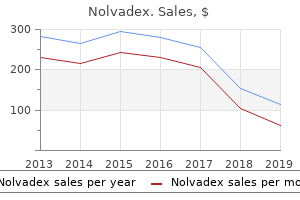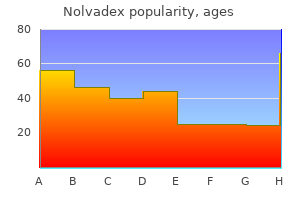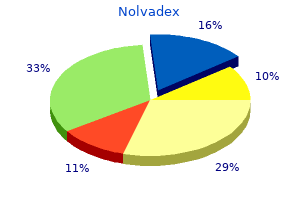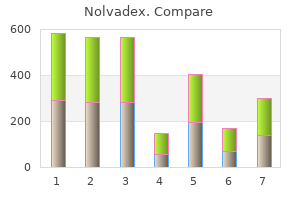

 5100 Springfield St. Suite 108, Dayton, Ohio 45431-1274
5100 Springfield St. Suite 108, Dayton, Ohio 45431-1274Nolvadex
"Cheap nolvadex on line, women's health clinic amarillo tx".
By: T. Tukash, M.B. B.A.O., M.B.B.Ch., Ph.D.
Vice Chair, University of Maryland School of Medicine
The most common site of infections in the adjuvant setting involved the upper respiratory tract womens health zoe saldana order nolvadex 10mg amex, skin women's health center norristown pa discount generic nolvadex canada, and urinary tract menstruation at 8 purchase nolvadex 10mg with visa. Fatal respiratory failure occurred in 3 patients receiving Herceptin, one as a component of multi-organ system failure, as compared to 1 patient receiving chemotherapy alone. In Study 3, there were 4 cases of interstitial pneumonitis in the one-year Herceptin treatment arm compared to none in the observation arm at a median follow-up duration of 12. Metastatic Breast Cancer Among women receiving Herceptin for treatment of metastatic breast cancer, the incidence of pulmonary toxicity was also increased. Pulmonary adverse events have been reported in the post-marketing experience as part of the symptom complex of infusion reactions. Pulmonary events include bronchospasm, hypoxia, dyspnea, pulmonary infiltrates, pleural effusions, non-cardiogenic pulmonary edema, and acute respiratory distress syndrome. Thrombosis/Embolism In 4 randomized, controlled clinical trials, the incidence of thrombotic adverse events was higher in patients receiving Herceptin and chemotherapy compared to chemotherapy alone in three studies (2. Of patients receiving Herceptin as a single agent for the treatment of metastatic breast cancer, 25% experienced diarrhea. An increased incidence of diarrhea was observed in patients receiving Herceptin in combination with chemotherapy for treatment of metastatic breast cancer. Renal Toxicity In Study 7 (metastatic gastric cancer) on the Herceptin-containing arm as compared to the chemotherapy alone arm the incidence of renal impairment was 18% compared to 14. Treatment discontinuation for renal insufficiency/failure was 2% on the Herceptin-containing arm and 0. In the post-marketing setting, rare cases of nephrotic syndrome with pathologic evidence of glomerulopathy have been reported. The time to onset ranged from 4 months to approximately 18 months from initiation of Herceptin therapy. Pathologic findings included membranous 20 glomerulonephritis, focal glomerulosclerosis, and fibrillary glomerulonephritis. The incidence of antibody formation is highly dependent on the sensitivity and the specificity of the assay. Additionally, the observed incidence of antibody (including neutralizing antibody) positivity in an assay may be influenced by several factors including assay methodology, sample handling, timing of sample collection, concomitant medications, and underlying disease. For these reasons, comparison of the incidence of antibodies to Herceptin with the incidence of antibodies to other products may be misleading. If possible, physicians should avoid anthracycline-based therapy for up to 7 months after stopping Herceptin. If Herceptin is administered during pregnancy, or if a patient becomes pregnant while receiving Herceptin or within 7 months following the last dose of Herceptin, health care providers and patients should immediately report Herceptin exposure to Genentech at 1-888-835-2555. In post-marketing reports, use of Herceptin during pregnancy resulted in cases of oligohydramnios and of oligohydramnios sequence, manifesting as pulmonary hypoplasia, skeletal abnormalities, and neonatal death [see Data]. There are clinical 21 considerations if Herceptin is used in a pregnant woman or if a patient becomes pregnant within 7 months following the last dose of Herceptin [see Clinical Considerations]. Clinical Considerations Fetal/Neonatal Adverse Reactions Monitor women who received Herceptin during pregnancy or within 7 months prior to conception for oligohydramnios. If oligohydramnios occurs, perform fetal testing that is appropriate for gestational age and consistent with community standards of care. Data Human Data In post-marketing reports, use of Herceptin during pregnancy resulted in cases of oligohydramnios and of oligohydramnios sequence, manifesting in the fetus as pulmonary hypoplasia, skeletal abnormalities, and neonatal death. These case reports described oligohydramnios in pregnant women who received Herceptin either alone or in combination with chemotherapy. In one case, Herceptin therapy resumed after amniotic index improved and oligohydramnios recurred. Animal Data In studies where trastuzumab was administered to pregnant Cynomolgus monkeys during the period of organogenesis at doses up to 25 mg/kg given twice weekly (up to 25 times the recommended weekly human dose of 2 mg/kg), trastuzumab crossed the placental barrier during the early (Gestation Days 20 to 50) and late (Gestation Days 120 to 150) phases of gestation.

Page 4 of 34 Renal Impairment the disposition of levetiracetam was studied in adult subjects with varying degrees of renal function menstrual distress questionnaire order nolvadex online pills. Approximately 50% of the pool of levetiracetam in the body is removed during a standard 4-hour hemodialysis procedure breast cancer 6 lymph nodes effective nolvadex 20 mg. Hepatic Impairment In subjects with mild (Child-Pugh A) to moderate (Child-Pugh B) hepatic impairment breast cancer tattoo design 20mg nolvadex for sale, the pharmacokinetics of levetiracetam were unchanged. In patients with severe hepatic impairment (Child-Pugh C), total body clearance was 50% that of normal subjects, but decreased renal clearance accounted for most of the decrease. In these studies, 904 patients were randomized to placebo, 1000 mg, 2000 mg, or 3000 mg/day. During the baseline period, patients had to have experienced at least two partial onset seizures during each 4-week period. After a prospective baseline period of 12 weeks, patients were randomized to one of the three treatment groups described above. The primary measure of effectiveness was a between group comparison of the percent reduction in weekly partial seizure frequency relative to placebo over the entire randomized treatment period (titration + evaluation period). Secondary outcome variables included the responder rate (incidence of patients with 50% reduction from baseline in partial onset seizure frequency). Figure 1: Responder Rate (50% Reduction From Baseline) In Study 1 45% 40% 35% 30% % of Patients 39. Page 6 of 34 the first period of the study (Period A) was designed to be analyzed as a parallel-group study. After a prospective baseline period of up to 12 weeks, patients were randomized to one of the three treatment groups described above. After a prospective baseline period of 12 weeks, patients were randomized to one of two treatment groups described above. The primary measure of effectiveness was a between group comparison of the percent reduction in weekly seizure frequency relative to placebo over the entire randomized treatment period (titration + evaluation period). The study consisted of an 8-week baseline period and 4 week titration period followed by a 10-week evaluation period. The primary measure of effectiveness was a between group comparison of the percent reduction in weekly partial seizure frequency relative to placebo over the entire 14-week randomized treatment period (titration + evaluation period). Secondary outcome variables included the responder rate (incidence of patients with 50% reduction from baseline in partial onset seizure frequency per week). Figure 4: Responder Rate (50% Reduction From Baseline) Page 9 of 34 45% 40% 35% 30% % of Patients 44. Patients were titrated over 4 weeks to a target dose of 3000 mg/day and treated at a stable dose of 3000 mg/day over 12 weeks (evaluation period). The primary measure of effectiveness was the proportion of patients with at least 50% reduction in the number of days per week with one or more myoclonic seizures during the treatment period (titration + evaluation periods) as compared to baseline. The 8-week combined baseline period is referred to as "baseline" in the remainder of this section. Each of these syndromes of idiopathic generalized epilepsy was well represented in this patient population. Patients were titrated over 4 weeks to a target dose of 3000 mg/day for adults or a pediatric target dose of 60 mg/kg/day and treated at a stable dose of 3000 mg/day (or 60 mg/kg/day for children) over 20 weeks (evaluation period). There were four suicides in drug-treated patients in the trials and none in placebo-treated patients, but the number is too small to allow any conclusion about drug effect on suicide. The risk did not vary substantially by age (5-100 years) in the clinical trials analyzed.
Foodborne illness is considered to be any illness that is related to food ingestion; gastrointestinal tract symptoms are the most common clinical manifestations of foodborne illnesses breast cancer 70 year old nolvadex 10 mg with amex. This document provides detailed summary tables and charts menopause exhaustion order nolvadex, references menstrual reg quality 20 mg nolvadex, and resources for health care professionals. Patient scenarios and clinical vignettes are included for selfevaluation and to reinforce information presented in this primer. This primer is not a clinical guideline or definitive resource for the diagnosis and treatment of foodborne illness. Safe food handling practices and technologies (eg, irradiation, food processing and storage) also are not addressed. More detailed information on these topics is available in the references and resources listed in this document, as well as from medical specialists and medical specialty societies, state and local public health authorities, and federal government agencies. Also refer to this section and the accompanying Foodborne Illnesses Tables when working through the various Patient Scenarios and the Clinical Vignettes portion of this primer. Recognizing Foodborne Illness Patients with foodborne illnesses typically present with gastrointestional tract symptoms (eg, vomiting, diarrhea, abdominal pain); however, nonspecific symptoms and neurologic symptoms may also occur. A physician or health care professional who encounters this person may be the only one with the opportunity to make an early and expeditious diagnosis. Thus, the physician or health care professional must have a high degree of suspicion and ask appropriate questions to recognize that an illness may have a foodborne etiology. Additional clues may be derived by asking whether the patient has consumed raw or poorly cooked foods (eg, raw or undercooked eggs, meats, shellfish, fish), unpasteurized milk or juices, home-canned goods, fresh produce, or soft cheeses made from unpasteurized milk. Inquiries about living on or visiting a farm, pet contact, day care attendance, occupation, foreign travel, travel to coastal areas, camping excursions to mountains or other areas where untreated water is consumed, and attendance at group picnics or similar outings also may provide clues for determining the etiology of the illness. If a foodborne illness is suspected, submit appropriate specimens for laboratory testing and contact the state or local health department for advice about epidemiologic investigation. For the physician or other health care professional, implication of a specific source in disease transmission is difficult from a single patient encounter. Attempts to identify the source of the outbreak are best left to public health authorities. Because infectious diarrhea can be contagious and is easily spread, rapid and definitive identification of an etiologic agent may help control a disease outbreak. Early identification of a case of foodborne illness can prevent further exposures. An individual physician who obtains testing can contribute the clue that ultimately leads to identification of the source of an outbreak. Clinical Considerations Food-related disease threats are numerous and varied, involving biological and nonbiological agents. Foodborne illnesses can be caused by microorganisms and their toxins, marine organisms and their toxins, fungi and their related toxins, and chemical contaminants. During the last 20 years, some foods that have been linked to outbreaks include milk (Campylobacter); shellfish (noroviruses); unpasteurized apple cider (Escherichia coli O157:H7), raw and undercooked eggs (Salmonella); fish (ciguatera poisoning); raspberries (Cyclospora); strawberries (hepatitis A virus); and ready-to-eat meats (Listeria). While physicians and other health care professionals have a critical role in surveillance for and prevention of potential disease outbreaks, only a fraction of the people who experience gastrointestinal tract symptoms from foodborne illness seek medical care. In those who do seek care and submit specimens, bacteria are more likely than other pathogens to be identified as causative agents. Bacterial agents most often identified in patients with foodborne illness in the United States are Campylobacter, Salmonella, and Shigella species, with substantial variation occurring by geographic area and season. Testing for viral etiologies of diarrheal disease is rarely done in clinical practice, but viruses are considered the most common cause of foodborne illness. This section and the accompanying Foodborne Illnesses Tables summarize diagnostic features and laboratory testing for bacterial, viral, parasitic, and noninfectious causes of foodborne illness.
Purchase cheapest nolvadex and nolvadex. Veg Pulao Recipe in Hindi | Vegetable Pulao in Pressure Cooker | Lunch & Dinner Recipe.

A big thank you for following along - all your love and support for my little business mean so much pregnancy 6 weeks 6 days buy nolvadex 10mg without prescription. The decrease in the effectiveness of antibiotics in treating common infections has become a world-wide burden menstrual molimina generic nolvadex 10 mg without a prescription. In recent years there has been the presence of untreated strains of carbapenem resistant enterobacteriacae [1] womens health 7 minute workout discount 10mg nolvadex. The increase in resistance is facilitated by interspecies gene transmission, lack of good sanitation and hygiene in the hospital and community thereby causing an increase in the frequency of global trade and disease transmission [2]. Staphylococcus aureus is the most common cause of Staphyloccocal infection and they are responsible for different diseases such as skin infection, wound infections and toxin mediated diseases [3]. The strain expressed a modified Introduction penicillin-binding protein encoded by MecA gene. This resulted in the emergence of vancomycin intermediate and vancomycin resistant S. Antibiotic sensitivity test by Kirby-Bauer Disc Diffusion In developing countries such as Nigeria, street (food) vendors have formed an integral part of the food supply chain. The main concern is the sanitary conditions of these street food vendors based on the fact Staphylococcal food poisoning can occur in which a toxic substance produced by the bacteria is ingested with the food [8]. Antibiotic sensitive test was carried out using Kirby-Bauer disc diffusion method. A sterile inoculating loop was used to pick a colony of the isolate and transferred in each of the 5ml normal saline and homogenized properly until it becomes slightly turbid. Gram positive antibiotic disc were placed on the surface and press gently using sterile forceps. Antibiotic resistance and susceptibility was determined after 24 hours by measuring the zone of inhibition in millimeter. The clinical isolates were isolated from swabs from various sources in the hospital. The remaining sixty swabs were used to swab the hands of food vendors within the University of Port Harcourt. The plates were incubated at 37o C for 24 hours after which the colonial characteristics were observed. The isolates that were positive cocci, catalase positive and coagulase human plasma were considered S. Muller Hinton agar plates were inoculated with the bacterial suspension which was adjusted to 0. The isolates were identified by carrying out standard microbiological test such Gram staining, coagulase and catalase test to identify S. For microscopic observation, a pure colony was selected and subjected to Gram staining. The shape, arrangement, and Gram reactions of the isolates were observed under a light microscope (at a magnification of 100x). Confirmatory biochemical tests including catalase and triple sugar iron agar tests were performed to identify suspected S. These isolates were identified by their characteristic, arrangement and biochemical test. Characterization of Staphylococcus aureus isolation 0094 How to cite this article: Otobo U, Wala P, Agbagwa O. Occurrence of Vancomycin-Resistant Staphylococcus Aureus (Vrsa) In Clinical and Community Isolates Within the University of Port Harcourt.

Approximately onehalf of the patients who discontinued (9% of the total) had multiple complaints pregnancy day by day calendar nolvadex 10mg with visa, none of which could be classified as primary breast cancer month 20mg nolvadex with mastercard. Where a primary reason for discontinuation could be identified women's health who 20 mg nolvadex amex, most patients discontinued because of nervous system complaints (5. There was no apparent relationship between the adverse events and elevated plasma drug concentrations. The frequencies were obtained from pooled data of clinical trials involving either adults receiving Anafranil (N=322) or placebo (N=319) or children treated with Anafranil (N=46) or placebo (N=44). The prescriber should be aware that these figures cannot be used to predict the incidence of side effects in the course of usual medical practice, in which patient characteristics and other factors differ from those that prevailed in the clinical trials. The cited figures, however, provide the physician with a basis for estimating the relative contribution of drug and nondrug factors to the incidence of side effects in the populations studied. Other Events Observed During the Premarketing Evaluation of Anafranil During clinical testing in the U. Consequently, it is not possible to provide a meaningful estimate of the proportion of individuals experiencing adverse events without first grouping similar types of untoward events into a smaller number of standardized event categories. In the tabulations that follow, a modified World Health Organization dictionary of terminology has been used to classify reported adverse events. The frequencies presented, therefore, represent the proportion of the 3525 individuals exposed to Anafranil who experienced an event of the type cited on at least one occasion while receiving Anafranil. All events are included except those already listed in the previous table, those reported in terms so general as to be uninformative, and those in which an association with the drug was remote. It is important to emphasize that although the events reported occurred during treatment with Anafranil, they were not necessarily caused by it. Events are further categorized by body system and listed in order of decreasing frequency according to the following definitions: frequent adverse events are those occurring on one or more occasions in at least 1/100 patients; infrequent adverse events are those occurring in 1/100 to 1/1000 patients; rare events are those occurring in less than 1/1000 patients. Rare - aneurysm, atrial flutter, bundle branch block, cardiac failure, cerebral hemorrhage, heart block, myocardial infarction, myocardial ischemia, peripheral ischemia, thrombophlebitis, vasospasm, ventricular tachycardia. Rare - cheilitis, chronic enteritis, discolored feces, gastric dilatation, gingival bleeding, hiccup, intestinal obstruction, oral/pharyngeal edema, paralytic ileus, salivary gland enlargement. Rare - dystonia, exostosis, lupus erythematosus rash, bruising, myopathy, myositis, polyarteritis nodosa, torticollis. Rare - anticholinergic syndrome, aphasia, apraxia, catalepsy, cholinergic syndrome, choreoathetosis, generalized spasm, hemiparesis, hyperesthesia, hyperreflexia, hypoesthesia, illusion, impaired impulse control, indecisiveness, mutism, neuropathy, nystagmus, oculogyric crisis, oculomotor nerve paralysis, schizophrenic reaction, stupor, suicide. Rare - chloasma, folliculitis, hypertrichosis, piloerection, seborrhea, skin hypertrophy, skin ulceration. Rare - blepharitis, chromatopsia, conjunctival hemorrhage, exophthalmos, glaucoma, keratitis, labyrinth disorder, night blindness, retinal disorder, strabismus, visual field defect.
